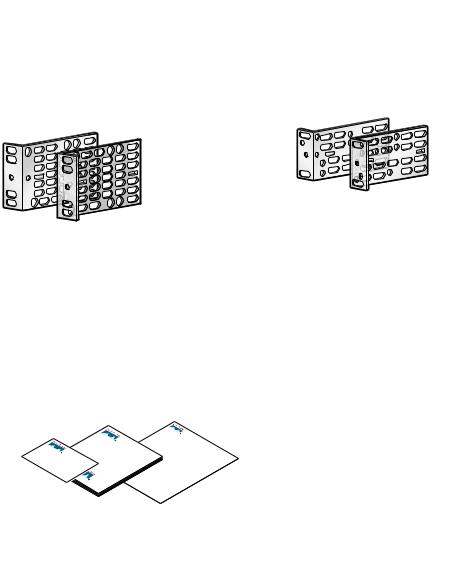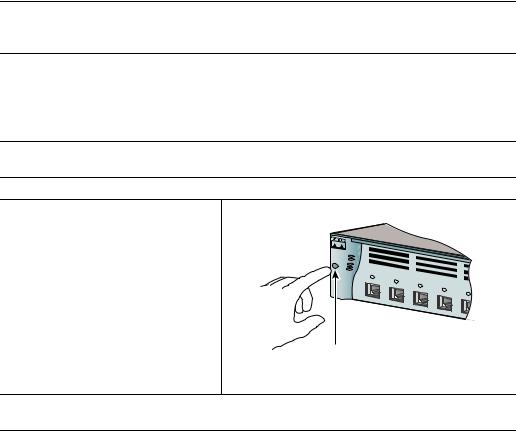Cisco Systems 3550 User Manual

Getting Started Guide
Catalyst 3550 Multilayer Switch Getting Started Guide
INCLUDING LICENSE AND WARRANTY
1About this Guide
2Taking Out What You Need
3Running Express Setup
4Managing the Switch
5Rack-Mounting
6Connecting to DC Power
7In Case of Difficulty
8Obtaining Documentation
9Obtaining Technical Assistance
10 Cisco Limited Lifetime Hardware Warranty Terms

1 About this Guide
This guide provides instructions on how to use Express Setup to initially configure your Catalyst switch. Also covered are switch management options, basic rack-mounting procedures, port and module connections, power connection procedures for both ACand DC-powered switches, and troubleshooting help.
For additional installation and configuration information, and technical specifications, refer to the Catalyst 3550 documentation on Cisco.com. For system requirements, important notes, limitations, open and resolved bugs, and last-minute documentation updates, see the release notes, also on Cisco.com.
When using the online publications, refer to the documents that match the Cisco IOS software version running on the switch. The software version is on the Cisco IOS label on the switch rear panel.
You can order printed copies of the manuals from the Cisco.com sites and from the telephone numbers listed in the “Obtaining Documentation” section on page 23.
For translations of the warnings that appear in this publication, refer to the Regulatory Compliance and Safety Information for the Catalyst 3550 Multilayer Switch that accompanies this guide.
2 Taking Out What You Need
Follow these steps:
1.Unpack and remove the switch and the accessory kit from the shipping box.
2.Return the packing material to the shipping container, and save it for future use.
3.Verify that you have received the items shown on page 3. If any item is missing or damaged, contact your Cisco representative or reseller for instructions. Some switch models might include additional items that are not shown on page 3.
Equipment That You Supply to Run Express Setup
You need to supply this equipment to run Express Setup:
•PC
•Ethernet (Category 5) straight-through cable (as shown)
2

Shipping Box Contents
|
SYSTEM |
|
RPS |
MODE |
STATUS |
|
UTIL |
|
DUPLX |
|
SPEED |
1
2
3
4
5
6

 Catalyst 3550 7 8 9 10
Catalyst 3550 7 8 9 10
1
2
Two 19-inch mounting brackets
Console cable
AC power cord (AC-powered switches only)
|
Catalyst |
|
|
|
Regulatory |
|
||||
|
Getting |
|
|
|
|
and |
Safety |
|
|
|
|
|
3550 |
|
Catalyst |
|
Compliance |
||||
Product |
|
Started |
|
|
|
3550 |
|
|
||
Cisco |
|
|
Switch |
|
the |
|
||||
Registration |
|
|
|
|
|
|
|
Information |
||
|
|
|
Guide |
|
|
Switch |
||||
Ownershipcard |
|
|
|
|
|
|
|
|||
|
|
|
|
|
|
|
|
|
|
|
Documentation
Four rubber mounting feet
Two 19-inch mounting brackets


 Four number-12 Phillips machine screws
Four number-12 Phillips machine screws

 Four number-8 Phillips truss-head screws
Four number-8 Phillips truss-head screws 

 Six number-8 Phillips flat-head screws
Six number-8 Phillips flat-head screws
Connector cover for redundant power system (RPS)
Two number-4 pan-head screws
Cable guide
One black Phillips machine screw
 Terminal block
Terminal block 

 (DC-powered switches only)
(DC-powered switches only)
Ground lug
(DC-powered switches only)
Two number-10-32 screws
3

3 Running Express Setup
When you first set up the switch, you should use Express Setup to enter the initial IP information. This enables the switch to connect to local routers and the Internet. You can then access the switch through the IP address for further configuration.
To run Express Setup:
Step 1 Verify that no devices are connected to the switch, because during Express Setup, the switch acts as a DHCP server. If your PC has a static IP address, before you begin you should change your PC settings to temporarily use DHCP.
Step 2 Connect the AC power cord to the switch and to a grounded AC outlet. The power-on self-test (POST) begins. During POST, the LEDs blink while a series of tests verify that the switch functions properly.
For a DC-powered switch, see the “Connecting to DC Power” section on page 17 for wiring instructions.
Step 3 Wait for the switch to complete POST. It might take several minutes for the switch to complete POST.
Step 4 |
Verify that POST has completed by confirming that the SYST and STAT LEDs are green. |
|
Step 5 |
Press and hold the Mode button for |
|
|
3 seconds. When all of the LEDs |
|
|
above the Mode button turn green, |
|
|
release the Mode button. |
RPS |
|
|
SYSTEM |
|
|
MODE STATUS |
If the LEDs above the Mode button begin to blink after you press the button, release it. Blinking LEDs mean that the switch has already been configured and cannot go into Express Setup mode. For more information, see the “Resetting the Switch” section on page 21.
UTIL
DUPLX
SPEED
1
2
3
4
5
Mode button
Step 6 Verify that the switch is in Express Setup mode by confirming that all LEDs above the Mode button are green. (The RPS LED remains off on some switch models.)
4

Step 7 Connect a straight-through Category 5 Ethernet cable (not provided) to any 10/100 or 10/100/1000 Ethernet port on the switch front panel and to the Ethernet port on the PC.
Step 8 Verify that the LEDs on both Ethernet ports are green.
Step 9 Wait 30 seconds.
Step 10 Launch a web browser on your PC. Enter the IP address 10.0.0.1 in the web browser, and press Enter.
Catalyst 3550
DHCP-enabled PC
Step 11 The Express Setup page appears. If it does not appear, see the “In Case of Difficulty” section on page 20 for help.
5

Step 12 Enter this information in the Network Settings fields:
•In the Management Interface (VLAN ID) field, the default is 1. Enter a new VLAN ID only if you want to change the management interface through which you manage the switch and to which you assign IP information. The VLAN ID range is 1 to 1001.
•In the IP Address field, enter the IP address of the switch. In the IP Subnet Mask field, click the drop-down arrow, and select an IP Subnet Mask.
•In the Default Gateway field, enter the IP address for the default gateway (router).
•Enter your password in the Switch Password field. The password can be from 1 to 25 alphanumeric characters, can start with a number, is case sensitive, allows embedded spaces, but does not allow spaces at the beginning or end. In the Confirm Switch Password field, enter your password again.
Step 13 (Optional) You can enter the Optional Settings information now or enter it later by using the device manager interface:
•In the Host Name field, enter a name for the switch. The host name is limited to 31 characters; embedded spaces are not allowed.
•In the System Contact field, enter the name of the person responsible for the switch. In the System Location field, enter the wiring closet, floor, or building where the switch is located.
•In the Telnet Access field, click Enable if you are going to use Telnet to manage the switch by using the command-line interface (CLI). If you enable Telnet access, you must enter a Telnet password.
•In the Telnet Password field, enter a password. The Telnet password can be from 1 to 25 alphanumeric characters, is case sensitive, allows embedded spaces, but does not allow spaces at the beginning or end. In the Confirm Telnet Password field, enter the Telnet password again.
•In the SNMP field, click Enable to enable Simple Network Management Protocol (SNMP). Enable SNMP only if you plan to manage switches by using CiscoWorks2000 or another SNMP-based network-management system.
If you enable SNMP, you must enter a community string in the SNMP Read Community field, the SNMP Write Community field, or both. SNMP community strings authenticate access to MIB objects. Embedded spaces are not allowed in SNMP community strings. When you set the SNMP read community, you can access SNMP information, but cannot modify it. When set the SNMP write community, you can access and modify SNMP information.
6

Step 14 Click Submit to save your settings, or click Cancel to clear your settings.
When you click Submit, the switch is configured and exits Express Setup mode. The PC displays a warning message and then attempts to connect with the new switch IP address. If you configured the switch with an IP address that is in a different subnet from the PC, connectivity between the PC and the switch is lost.
Step 15 Disconnect the switch from the PC, and install the switch in your production network. See the “Managing the Switch” section on page 7 for information about configuring and managing the switch.
If you need to rerun Express Setup, see the “Resetting the Switch” section on page 21.
Refreshing the PC IP Address
After you complete Express Setup, you should refresh the PC IP address.
For a dynamically assigned IP address, disconnect the PC from the switch, and reconnect it to the network. The network DHCP server will assign a new IP address to the PC.
For a statically assigned IP address, change it to the previously configured IP address.
4 Managing the Switch
After completing Express Setup and installing the switch in your network, use the device manager or other management options described in this section for further configuration.
Using the Device Manager
The simplest way to manage the switch is by using the device manager that is in the switch memory. This is an easy-to-use web interface that offers quick configuration and monitoring. You can access the device manager from anywhere in your network through a web browser.
Follow these steps:
1.Launch a web browser on your PC or workstation.
2.Enter the switch IP address in the web browser, and press Enter. The device manager page appears.
3.Use the device manager to perform basic switch configuration and monitoring. Refer to the device manager online help for more information.
4.For more advanced configuration, download and run the Cisco Network Assistant described in the next section.
7
Downloading Cisco Network Assistant
Cisco Network Assistant is a free software program that you download from Cisco.com and run on your PC. Network Assistant offers advanced options for configuring and monitoring multiple devices, including switches, switch clusters, switch stacks, routers, and access points.
Follow these steps:
1.From the device manager page, select Network Assistant.
2.Follow the instructions to download the program to your PC.
3.Use the Network Assistant to configure and monitor multiple switches and devices. Refer to the Network Assistant online help and the getting started guide for more information.
Command-Line Interface
You can enter Cisco IOS commands and parameters through the CLI. Access the CLI either by connecting your PC directly to the switch console port or through a Telnet session from a remote PC or workstation.
Follow these steps:
1.Connect the supplied RJ-45-to DB-9 adapter cable to the standard 9-pin serial port on the PC. Connect the other end of the cable to the console port on the switch.
2.Start a terminal-emulation program on the PC.
3.Configure the PC terminal emulation software for 9600 baud, 8 data bits, no parity, 1 stop bit, and no flow control.
4.Use the CLI to enter commands to configure the switch. Refer to the software configuration guide and the command reference for more information.
Other Management Options
You can use SNMP management applications such as CiscoWorks Small Network Management Solution (SNMS) and HP OpenView to configure and manage the switch. You also can manage it from an SNMP-compatible workstation that is running platforms such as HP OpenView or SunNet Manager.
The Cisco IE2100 Series Configuration Registrar is a network management device that works with embedded CNS agents in the switch software. You can use IE2100 to automate initial configurations and configuration updates on the switch.
See the “Accessing Help Online” section on page 21 for a list of supporting documentation.
8
5 Rack-Mounting
This section covers basic 19-inch rack-mounting and switch port connections. The illustrations in this section show the Catalyst 3550-12T and 3550-24 switch for examples. You can install and connect other Catalyst 3550 switches as shown in these illustrations. For alternate mounting procedures, such as installing the switch in a 24-inch rack or on a wall, and for additional cabling information, refer to the Catalyst 3550 Multilayer Switch Hardware Installation Guide on Cisco.com.
Equipment That You Supply
You need to supply a number-2 Phillips screwdriver to rack-mount the switch.
Before you Begin
When determining where to install the switch, verify that these guidelines are met:
•Airflow around the switch and through the vents is unrestricted.
•Temperature around the switch does not exceed 113°F (45°C).
•Humidity around the switch does not exceed 85 percent.
•Altitude at the installation site is not greater than 10,000 feet (3049 m).
•Clearance to the switch front and rear panels meets these conditions:
–Front-panel LEDs can be easily read.
–Access to ports is sufficient for unrestricted cabling.
–AC power cord can reach from the AC power outlet to the connector on the switch rear panel.
–DC source wires can reach from the circuit breaker to the terminal block plug on the switch rear panel.
•Cabling is away from sources of electrical noise, such as radios, power lines, and fluorescent lighting fixtures.
•For 10/100 ports and 10/100/1000 ports, the cable length from a switch to an attached device cannot exceed 328 feet (100 meters).
•For 100BASE-FX ports, the cable length from a switch to an attached device cannot exceed 6562 feet (2 kilometers).
•For cable lengths for Gigabit Interface Converter (GBIC) modules, refer to the documentation that shipped with the module.
9

Installation Warning Statements
This section includes the basic installation warning statements.
Warning
Warning
Warning
Warning
Warning
Warning
To prevent the switch from overheating, do not operate it in an area that exceeds the maximum recommended ambient temperature of 113°F (45°C). To prevent airflow restriction, allow at least 3 inches (7.6 cm) of clearance around the ventilation openings.
Statement 17B
This equipment is intended to be grounded. Ensure that the host is connected to earth ground during normal use. Statement 39
Only trained and qualified personnel should be allowed to install, replace, or service this equipment. Statement 1030
If a redundant power system (RPS) is not connected to the switch, install an RPS connector cover on the back of the switch. Statement 265
Class 1 laser product. Statement 1008
To prevent bodily injury when mounting or servicing this unit in a rack, you must take special precautions to ensure that the system remains stable. The following guidelines are provided to ensure your safety:
•This unit should be mounted at the bottom of the rack if it is the only unit in the rack.
•When mounting this unit in a partially filled rack, load the rack from the bottom to the top with the heaviest component at the bottom of the rack.
•If the rack is provided with stabilizing devices, install the stabilizers before mounting or servicing the unit in the rack. Statement 1006
10
